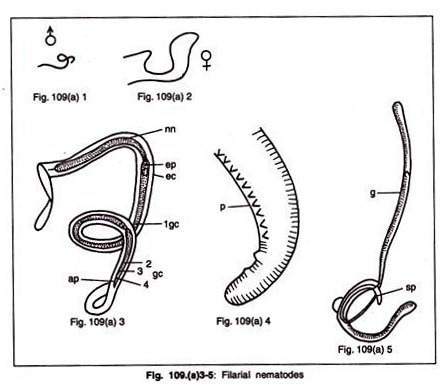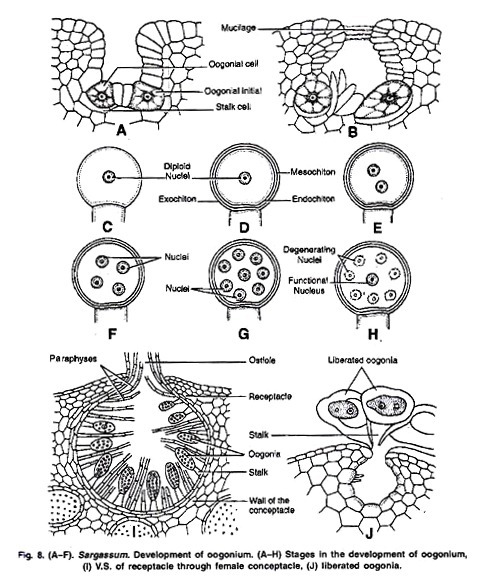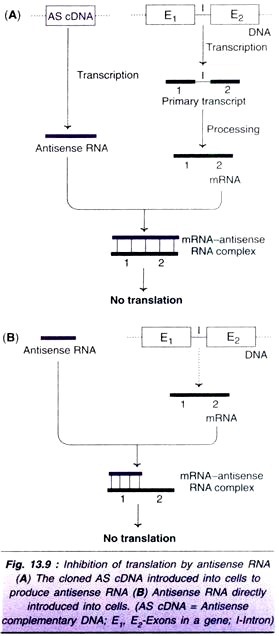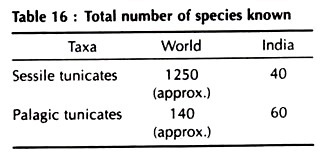Read this article to learn about Parts of a Typical Flower !
Flower develops on the mother axis (stem) in the form of floral bud.
A typical angiosperm flower has following parts:
1. Bract (= Hypsophyll):
It is a leaf like structure in whose axil a flower often develops.
2. Pedicel:
It is the stalk of the flower which may be short, long or even absent.
3. Bracteoles:
They are scaly appendages present on pedicel.
4. Receptacle (= Thalamus or Torus):
It is the swollen or expanded tip of the pedicel which bears four whorls i.e. calyx, corolla, androecium and gynoecium. Of these, calyx and corolla are collectively called as helping or accessory whorls, while androecium and gynoecium are together known as essential or reproductive whorls.
5. Floral whorls:
(a) Calyx:
It is the first or outermost protective whorl. Individual member of calyx is called a sepal which is generally green.
(b) Corolla:
It is the second or attractive whorl present inner to calyx. Each member of corolla is called a petal.
(c) Androecium:
It is the third or male whorl. It is a collection of male parts called stamens. Each stamen is a modified leaf or microsporophyll. Each stamen consists of 3 parts – filament, anther and connective. Each anther has two anther lobes and each lobe usually contains two pollen sacs or micro-sporangia filled with pollen grains or microspores.
(d) Gynoecium or Pistil:
It is the fourth or female whorl, arid its functional units are called carpels (= megasporophylls). A typical carel consists of ovary, style and stigma. Ovary is the swollen basal part of the carpel that contains one or more ovules. Each ovule connected to the ovary wall through a special tissue called palacenta.
Bracts:
Bracts are specialized leaves from the axil of which bracteate flowers arise.
Bracts vary in size, colour and duration and are of following kinds:
(i) Foliaceous or Leafy bracts:
Green, flat and leaf like, e.g., Acalypbn, Adhatuda Gynandropsis.
(ii) Spathe:
Large, boat-shaped and tightly coloured bract enclosing lowers, e.g., banana, palms, Coloscassia.
(iii) Petaloid bracts:
Brightly coloured bracts like petals, e.g Polnsettia (Euphorbia pulcherrima)
(iv) Involucre:
Group of bracts in one or more whorls around luster of flowers, e.g., sunflower.
(v) Epicalyx:
Whorl of bracteoles arising at the base of tie calyx, e.g., cotton, lady’s finger, strawberry.
(vi) Glumes:
Small and dry scaly bracts found only in gasses and sedges.
(vii) Scaly bract:
Present at the base of each floret of members of compositae, e.g., sunflower.
Calyx:
The calyx is the outermost whorl which consists of sepals.
1. Colour:
(a) Sepaloid: When sepals are green.
(b) Petaloid: When sepals are coloured, e.g., Mirabilis, Delphinium
2. Fusion:
(i) Polysepalous – When sepals are free, e.g., Mustard
(b) Gamosepalous – When sepals are united, e.g., Datura, Hibiscus
3. Duration:
(a) Caducous (Fugacious):Sepals that fall-off early or prematurely, e.g., Argemone, Papaverine.
(b) Deciduous: Sepals fall-off along with the petals just after fertilization, e.g., Brassica.
(c) Persistent: They remain attached to the fruit, e.g., tomato, brinjal, Solatium, Datura etc.
(d) Marcescent: This is also a persistent calyx, but it takes shrivelled, and dried-up looks, e.g., Guava (Psidium guajava).
(e) Accrescent: Again a persistent calyx but growing in size along with the fruit, e.g., Physalis, Shorea.
4. Modifications of Calyx:
Though sepals are generally green and leaf like structures, yet in some plants, they get modified in several forms, such as given below, for various purposes :-
(a) Pappus-Hairy or feathery sepals, e.g., Sonchus, Vernonia, sunflower etc.
(b) Spurred- When one or more sepals become beak-like outgrowth called spur, e.g., Impatiens, Delphinium.
(c) Leafy-Leaf-like sepals, e.g., in Mussaenda one of the sepals is modified into yellow leaf-like to attract insects for pollination.
(d) Spinous – Persistent sepals modified into spines, e.g., Trapa.
(e) Hood-like:
Such as in Aconitum, one of the sepals is modified into a hood like structure thus covering the whole flower.
(f) Bilabiate:
In family Labiatae, the calyx is bilabiate, differentiated into an upper and a lower lip. Each lip is composed of one or more sepals, e.g., Ocimum (Tulsi – here there is one sepal in the upper lip and four in the lower lip), Salvia (three in upper lip and two in lower lip).
Corolla:
Corolla is the second floral whorl present inner to calyx and meant for attracting agents of pollination. It consists of individual units called petals. Each petal is differentiated into a narrow claw and an expanded limb.
1. Colour:
(a) Petoloid – Coloured petals other than green.
(b) Sepal old – Petals green like sepals, e.g., Magnolia. Polyalthia.
2. Fusion:
(a) Polypetalous – Petals free, e.g. Brassica.
(b) Gamopetalous – Petals united, e.g., Datura, Petunia.
3. Shape:
I. Polypetalous and Regular:
(a) Cruciform – Corolla with four petals arranged in form of a cross, e.g., Brassica, Iberis etc.
(b) Caryophyllaceous – Corolla with five petals arranged in such a manner that the limbs lie right angles to the claws, e.g., Silene, Dianthus etc.
(c) Rosaceous – Petals five or more without any claws i.e., sessile, e.g., Rose, tea, apple etc.
II. Polypetalous and Irregular:
(a) Papilionaceous:
Here corolla with five petals appears butterfly shaped. The posterior large petal is called standard or vexillum, two lateral petals are called wings or alae and two innermost fused petals are called keel or carina. It is the characteristic of family Papilionaceae.
III. Gamopetalous and Regular:
(a) Tubular – tube-like or cylindrical corolla, e.g., disc florets of sunflower.
(b) Campanulate-bell-shaped corolla, e.g., Campanula, Physalis.
(c) Infundibuliform-furmel-shapedcorolla, e.g.,Petunia, Datura
(d) Rotate – wheel-shaped corolla, e.g., Calotropis, brinjal.
(e) Hypocrateriform-Salver-shaped corolla, e.g., Vinca.
(f) Urceolate-Um-shapedcorolla, e.g.,Bryophyllum.
IV. Gamopetalous and Irregular:
(a) Ligulate-Strap-shaped corolla, e.g., ray florets.
(b) Bilabiate – two-lipped corolla where lips remain always open, e.g., Salvia, Ocimum etc.
(c) Personate – two-lipped corolla where lips remain closed by a projection called Palate e.g., Antirrhinum (snapdragon), Lindenbergia.
4. Aestivation of Corolla and Calyx:
Aestivation is the mode of arrangement of sepals or petals in relation to one another in a floral bud. It is useful in classification and identification of plants.
It is of following types:
(i) Valvate:
The edges of sepals or petals touch or most not ‘ouch each other but do not overlap, e.g., mustard, coriander etc.
(ii) Twisted (contorted):
One edge of petal or sepal regularly overlaps the margin of the next one, e.g., petals of china rose.
(iii) Imbricate:
The overlapping becomes irregular. Out of five members, one is outer, one is inner and the rest three remain in twisted condition.
It has two sub-types:
a. Ascending Imbricate:
Posterior petal is innermost i.e. being overlapped by the lateral petals, e.g., Cassia.
b. Descending Imbricate (= vaxillary):
The posterior petal is outermost and largest that overlaps the lateral petals (wings). They in turn enclose the two anterior smallest petals (keels). It is also called papilionaceous.
(iv) Quincuncia:
It is a modified imbricate type with 2 outer, 2 inner and one remain twisted, e.g., Ipomoea, guava etc.
Perianth:
When non-essential whorls (sepals and petals) are not distinct, they are collectively called periandi. The individual members of perianth are known as tepals, e.g.,Asphodelus, Onion. They may be sepaloid (greenish) orpetaloid (coloured other than green). The free and fused perianth is written as polyphyllous (= polytepalous) and gamophyllous (= gamotapelous) respectively.
Androecium:
Androecium, the male reproductive whorl of flower, is composed of stamens. A stamen (= microsprophyll) is made up of chiefly two parts: a large terminal portion, anther, and a stalk known as the filament. Each anther consists usually of two lobes connected together by a suture known as connective. Each anther lobe contains two cavities called pollen sacs, in which pollen-grains are produced (Fig. 6.10-A).
1. Number:
(a) Monandrous – one stamen
(b) Diandrous – two stamens
(c) Triandrous-three stamens
(d) Polyandrous- many stamens
2. (a) Inserted–stamens remain inside the corolla tube, e.g., Petunia.
(b) Exserted – stamens are longer and exposed out the corolla tube, e.g., Hibiscus, Acacia.
3. Length of Stamens:
(a) Isostemonous-when all stamens of a flower are of equal lengths, e.g., solarium.
(b) Heterostemnous – when length of stamens are unequal, e.g., Cassia
(c) Didynamous – stamens four, 2 short and 2 long, e.g., Ocimum
(d) Tetradynamous – stamens six, two outer short and inner four long, e.g., Brassica.
4. Arrangement of stamens:
(a) Diplostemonous – Stamens arranged in two whorls, outer whorl alternate with the petals (alternipetalous) and the inner whorl is opposite to petals (antipetalous), e.g., Cassia.
(b) Obdiplostemonous – When outer whorl of stamens is antipetalous and inner whorl is alternipetalous, e.g., Dianthus.
(c) Polystemonous – stamens arranged in more than 2 whorls.
5. (a) Fertile stamens-Stamens producing pollen.
(b) Staminode- stamens do not produce pollen i.e. non-functional, e.g., Salvia, Cassia.
6. (a) Monothecous -one-lobed anther, having 2 pollen chambers (bisporangiate), e.g., Malvaceae family.
(b) Dithecous-two-lobed anther, having4 pollen chambers (tetrasporangiate), e.g., Mustard.
7. Cohesion of Stamens:
(a) Adelpnous-When filaments are united but anthers remain free.
It is of three types –
i. Monoadelphous – Filaments of all stamens united in one bundle, e.g., Hibiscus.
ii. Diadelphous – Filaments of stamens are united to form two bundles, e.g., Pea.
iii. Polyadelphous – Filaments of stamens are united to form many bundles, e.g., Citrus, Castor, Cotton etc.
(b) Syngenesious – When anthers of stamens are fused and filaments remain free, e.g.,Helianthus, Tridax.
(c) Synandrous – When stamens are fused throughout their length, e.g., Cucurbita.
(d) Polyandrous – When stamens are free from one another, e.g., Ranunculus, Iberis etc.
8. Adhesion of stamens:
(a) Epipetalous – Fusion of stamens with petals, e.g., Datura, Ixora, tobacco, potato etc.
(b) Epitepalous (epiphyilous) – Stamens (used with tepals, e.g., Asparagus, Asphodelus etc.
(c) Gynandrous – Stamens fused with pistils, e.g., Calotropis.
The Flower [Flower—A Modified Shoot]
9. Fixation of anthers.
(a) Basifixed (Innate) – Filament attached to the base of the anther, e.g., Brassica, Datura.
(b) Dorsifixed- Filament attached to the dorsal (back) side of the anther, e.g. Passiflora, Sesbonia, Annona etc.
(c) Adnate-Filament attached along the entire length of anther, e.g. Magnolia, Nicotiana,Michelia, Nelumbium etc.
(d) Versatile – Filament attached to a point on the back or base of anther so as to let it swing freely, e.g., Delo- nix, grasses etc.
(e) Divergent (divaricate) – When two anther lobes separate due to enlarged connective, e.g., Tilia.
(f) Distractile – When two anther lobes are far apart, e.g., Salvinia.
Gynoecium:
Gynoecium, the female reproductive whorl of flower, consists of carpels (= megasporophylls). A carpel is differentiated into 3 parts-stigama, style and ovary. When gynoecium is sterile or underdeveloped, it is called pistillode.
1. Gynoecium may be classified broadly into two types:
(a) Simple or Monocarpellary:
It is composed of only one carpel, e.g., pea, all legumes.
(b) Compound or Multi-capillary:
It comprises more than one carpel. Such a type of gynoecium occurs in majority of seed plants. Again, it may be of following two types: –
Apocarpous:
Each carpel is free from the other forming a separate gynoecium, e.g., Ranunculus, Clematis, etc.
Syncarpous:
All the carpels are fused with one another forming a compound gynoecium, e.g., Brassica (mustard), Hibiscus (China rose), Solanum species etc.
2. Number of Carpels:
Depending upon the number of carpels, a syncarpous gynoecium may be of the following types:
(i) Bicarpellary: Comprises two carpels, e.g.,Sonchus, Coriandrum, Mussaenda.
(ii) Tricarpellary: With three carpels, e.g., Allium cepa (onion), etc.
(iii) Tetracarpellary: With four carpels, e.g., Duranta, Berberis, etc.
(iv) Pentacarpellary: With five carpels, e.g.. Hibiscus (China rose), Media (Neem), etc.
(v) Multicarpellary: With more than five carpels, e.g., Papaver.  3. Stigma:
3. Stigma:
It is the terminal part of pistil meant for receiving pollens at the time of pollination. On the basis of shape, stigma may be — capitate or round: Hibiscus, Citrus; plumose or feathery: grasses; Fid or Forked: Tridax; Discoid: Melia; Dumb-bell shaped: Thomoea; Hood-Like: poppy; Funnel-shaped: Crocus; Striated; Argemone
4. Style:
It is the tubular stalk that connect stigma with ovary.
It may be of following types-
(a) Terminal or Apical:
When style lies in the same straight line with the ovary, e.g., Hibiscus, Dianthus, etc.
(b) Lateral:
When style appears to be arising from the side of the ovary, such as in strawberry, mango.
(c) Gynobasic:
Sometimes, such as in the family Labiatae, the ovary is lobed and the style arises from the depression in the centre of the ovary. Such a style is termed as gynobasic, e.g., Ocimum.
(d) Petaloid:
When the style becomes flattened and coloured like petals, e.g., Canna, Iris.
5. Ovary:
It is the lowermost (basal) part of the gynoecium, develops by the in rolling of the carpels (megasporophylls) along the median line.
1. Position of the ovary on thalamus:
In relation with other floral whorls, the ovary may occupy any of the following positions:
(i) Superior Ovary:
When Ovary occupies the highest position on thalamus, and the three other whorls (viz., sepals, petals and stamens) are successively insert d below it, the ovary is called superior, e.g., Citrus (lemon), Hibiscus, Brassica, etc.
(ii) Semi-inferior:
Here the thalamus grows around the ovary to form a cup, and bears sepals, petals and stamens on the rim of the cup e.g., Rosa (Rose), Prunus, etc.
(iii) Inferior:
In this type, the thalamus completely covers the ovary and fuses with it. Sepals, petals and stamens emerge from the top of the ovary e.g., Coriandrum, Mussaenda, Cucurbita, etc.
2. Chambers (locules) of the Ovary:
Depending upon the numbers of locules, following types of ovaries can be recognized (Fig. 6.15). Mostly the number of locules corresponds to the number of carpels, but this is not the rule, because sometimes the number of locules may be more than the number of carpels due to the formation of false septa or less due to dissolution of septa.
(i) Unilocular:
Ovary with a single chamber, e.g., Pisum (pea).
(ii) Bilocular:
Ovary with two chambers, e.g., Solarium, Murraya, etc.
(iii) Trilocular:
Ovary with three chambers, e.g., Asphodelus, Euphorbia, Musa (Banana), etc.
6. Placentation:
The ovary of flower possesses one or more ovules which later on develop into seeds after fertilization. The ovule bearing region of the carpel is called placenta. The mode of arrangement of placentae and ovules within the ovary is called placentation.
It maybe of following types: (Fig. 6.16):
(a) Marginal:
When the gynoecium is monocarpellary apocarpous, the placentae bearing ovules are borne on the ventral suture, where the margins of the ovary wall fuse, e.g., family Leguminosae.
(b) Axile:
Ovary multilocular and ovules borne on central placenta, e.g., Hibiscus, Citrus, Solarium, Allium, tomato, etc.
(c) Parietal:
Ovary is unilocular but pistil is syncarpous. The ovules are borne on peripheral fused margins of carpels, e.g., Brassica, Papaya, Gourd etc.
(d) Free central:
Ovary is unilocular and ovules borne on a central column which is not connected to the ovary wall by any spetum, e.g., Dianthus, Silene, Primula etc.
(e) Basal:
Ovary is unilocular and a single ovule is borne at the base of the ovary.
(f) Superficial (Laminar):
Ovary is multilocular and the ovules are borne on septa as well as all over the inner surface, e.g., Nymphea.










